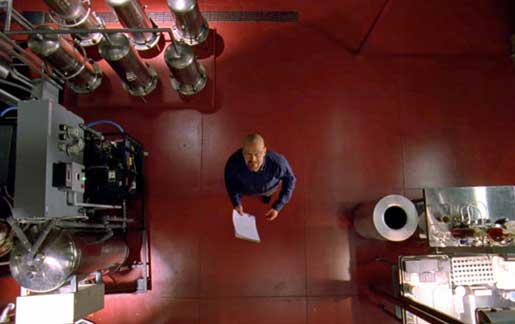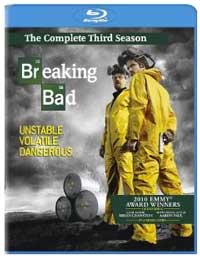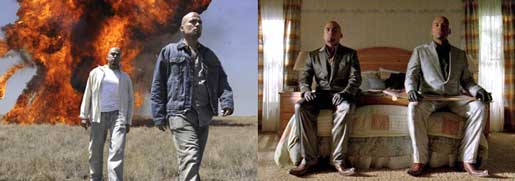
"Unstable, Volatile, Dangerous" is the subtitle for the Season 3 DVD of AMC's Breaking Bad (out here June 7). And believe it or not, it's an understatement. With an epic storyline now clocking almost three dozen episodes over three seasons, this series offers some of the most compelling and well-crafted television of a generation.
We're about to go into the fourth season (July 17 on AMC) with lead character Walter White (Bryan Cranston of Malcolm in the Middle), a once-brilliant chemist in corporate life with unlimited upside, who has somehow ended up as a dull, underachieving high-school chemistry teacher. (We don't have the full details on that yet.) On a routine doctor's visit he discovers he has inoperable lung cancer, with perhaps two years to live if he goes through treatment.

In fear of leaving his family unprovided for, Walt has unleashed the hounds. He "breaks bad" and begins to manufacture Blue Sky, his own brand of extremely pure crystal meth. He solicits the help of a slacker ex-student and low-level drug dealer, Jesse Pinkman (Aaron Paul), to help him make a giant financial score to leave behind.
It's a grim premise, and over three years, series creator and producer Vince Gilligan has pulled no punches. His is an unblinking look at the preposterously thin line that divides an ordinarily compliant man and his nihilist within. Gilligan, cast and crew have achieved something so rare in TV production, it almost never happens: a series sustaining a remarkably high level of writing and acting that delivers on a weekly basis.
Breaking Bad has leaped over all others with some of the smartest, darkly comic and visually beautiful material in recent memory. So palpable is the work, it's a very short step for us to stand in Walt's shoes -- in a bad position, facing even worse choices -- and become his unwitting, often willing accomplice.
Gilligan's Breaking Bad certainly takes its rightful place alongside Barry Levinson's Homicide: Life on the Street (1993-99) and Alan Ball's Six Feet Under (2001-05) as work with an unquestionably unique vision. It matches that with similarly intense, economical scripts and production values rivaling those of any film standard.
And while he's been at this character study of Walt, Gilligan has also burrowed into almost every dark corner of suburban life. While BB is part gritty crime show, at its heart it is also about the personal cost of domesticity in our crumbling economy and shifting culture. We find often ugly consequences behind the closed doors of the ranch houses, office parks and chicken joints. Breaking Bad has the White family under a microscope.

Except the Whites, as a family, and their desert environment are already vestigial. The usual green lawn is just an Albuquerque desert stone garden, the pool deck is scorched and faded, and the carpet hasn't been changed in 15 years. Walt's Pontiac is a crap, extinct Aztek -- a misspelling and modern relic now gone, like the natives hundreds of years ago.
And Walt himself is on the way out, too, and so maybe is his way of life -- the vanilla American suburbs and the family unit. The Whites' world in Breaking Bad is one bounded by street and drug culture, strip malls and an elite business world that eluded them years ago. These are two very well-educated, capable people, just making ends meet on one and a half low-scale incomes.
And now, they're unable to afford the treatment outside their HMO plan that would give Walter a better chance with his inoperable lung cancer.
Walt's is a case of a man, maybe the other Walter -- Thurber's Everyman, Walter Mitty -- who's seen his life now behind him. It's a far different one from youthful dreams, and turns him into more Mr. Hyde than Dr. Jekyll. Walt's wife, Skylar (Anna Gunn of Deadwood), seen in a foreshadowing green mask below, is eventually unmasked herself, her moral outrage not enough to overcome some outlaw impulses of her own.

One of the main triumphs of Breaking Bad is the merging of the art direction, design and story. The art direction by Marisa Frantz and Bjarne Sletteland, photography by two-time Emmy nominee Michael Slovis, and production design by Robb WIlson King and Mark S. Freeborn are as good as, or better than, their cinematic equivalents. And it's all been achieved on TV budgets and schedules.
Albuquerque, infamous as the place where Bugs Bunny should have made a left turn, is one of the main characters here: a desert landscape and blinding sun in stark contrast to the parched strip malls, motels and parking lots where much of Walt and Jesse's secret life takes place.

The characters are often silhouetted against this brilliant light, negations of what they once were -- dark masses borne from their new lives outside the law, outside of morality.
Similarly, this decidedly harsh light is let in by Gilligan, quite often through mini-blinds that make bars -- prison bars -- usually across Walt, either in some foreshadowing of how all this will turn out for him, but certainly suggestive of the everyday prison he's made for himself.

Walt and Jesse initially start "cooking" by producing small amounts of crystal meth inside an old RV camper, way out in the New Mexico desert where they're isolated on the vast horizon. In some manner, Breaking Bad is a frontier tale, two-bit criminals homesteading against the physical elements, and in this case, society as well. It's no coincidence that these men, taking what they think is due them, are sort of on the prairie in their "Little House," but in reverse, cooking up their own brand of frontier justice.

It's a perversion, of course, but very American in its underlying theme: You don't have to be right, or moral, but only ruthless enough to go outside the lines and make it happen.
Gilligan has discussed the long arc he's envisioned for BB, and unlike a lot of series characters, these will arrive at a very different place than where they started.
And so it has been with Walt, particularly visually. He's undergone a vivid transformation, losing his hair to chemotherapy, and stylizing himself with a jazz musician's hat for deals and meetings.

There have been three Emmy wins so far for Bryan Cranston, who has created and embodied the character of Walt to such a degree, it's hard to imagine anyone else ever in it. Cranston has a tremendous range, and has absolute command of Walt at his most invisible, most desperate, most vengeful. It's about as deep a character study as you'll find in any Dostoyevsky novel. Most likely deeper, and more complex.
As such, in the first two seasons Walt and Jesse were sometimes surrounded by childish or child-like objects, symbolizing their rise from two-bit meth lab wannabes into matching wits with the drug kings of the American southwest. It's often done to great comic effect, starting with the hose-down in the kiddie pool after a grisly clean-up in Season 1.
But the props in Breaking Bad cut both ways. The fallout from an air collision over Albuquerque (to which Walt was indirectly connected) included a burnt magenta teddy bear that landed in Walt's pool. It was a heartbreaking moment that vividly symbolized the devastating effects of Walt's choices on people around him -- and on his own innocence that is gone forever.

Jesse is also transformed this way, his playful hip-hop wardrobe (below) and juvenile attitude getting stripped away in layers, as he is forced to murder and forever be unable to regain the person he was before he stepped onto the big-league ladder of the Mexican meth cartel.
It's also a very colorful show, to great effect. The art directors and photographers have gone to great detail to shoot the Blue Sky meth in its liquid and crystal state, making something so addictive and destructive into something utterly seductive and blanketing as it slinks into flat glass pans to harden.

The same can also be said of the "super lab" in Season 3, which Gus, the Albuquerque meth overlord and fried chicken king has set up for Walt to cook in. It's an underground bunker, where Walt is tasked with the production of an astronomical 200 pounds of Blue Sky a week, meant to make Gus the undisputed kingpin, free of the Mexican drug cartel from which he's currently buying product.
Walt's finally achieved the state-of-the-art lab that's always eluded him, but with its red floor, he's landed in a true hell of his own making. (Photo at top of article.)
As good as BB has been, the three seasons haven't been without a few warts. Gilligan and the writers have used "The Unflinching Walk" twice (walking away from an explosion, stone cold, without looking back) and "The Sarcastic Confession" in Season 3 (telling the truth sarcastically so it seems like a joke). Then, there was the old "Bald of Evil" with the Salamanca cousins, also in Season 3. So, there isn't -- could never be -- complete freedom from the entirety of TV tradition that has come before the BB team.

But, no matter. The heights are too great. Perhaps unmatched -- or at least only to be equaled, never surpassed -- are images that have come out of Breaking Bad, unforgettable for their originality and, for lack of a better term, their raw surrealistic power.
While these moments in the show have dredged up dream imagery, they're all the more disturbing for the incidental way they just happen to drop in on ordinary circumstances.
I've been trying to think of an opening scene from a pilot episode equal to Walt, at the wheel of his out-of-control RV in his underwear and a gas mask, with two bodies in the back, or, the head of a DEA snitch showing up on a desert stakeout on the back of turtle.

I have to say I can't. And that's the wonder and dark beauty of Breaking Bad. Let's hope there's much more to come.
[AMC is running the first three seasons of Breaking Bad on Monday and Thursday late-nights, at broadcast times listed here. Season 4 debuts July 17 on AMC.]